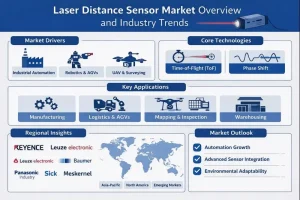Photonics Industry Growth Forecast: Illuminating the Path Ahead
The Photonics Industry is poised for significant expansion in the coming years, driven by rapid advancements in technology and increasing demand across multiple sectors. Photonics—a science and technology concerned with the generation, manipulation, and detection of light—has become integral to modern innovation, influencing areas such as telecommunications, healthcare, manufacturing, and consumer electronics. As the world continues to embrace digital transformation and automation, the demand for photonic devices and systems shows no signs of slowing down.
Understanding the Photonics Industry
At its core, the photonics industry revolves around technology that uses photons (particles of light). This includes lasers, optical fibers, sensors, light-emitting diodes (LEDs), and various imaging devices. Unlike electronics, which rely on the flow of electrons, photonics harnesses light to transmit information or perform precise tasks, offering significant advantages such as higher speed, enhanced precision, and reduced energy consumption.
The photonics industry has broad applications spanning diverse markets:
- Telecommunications: Fiber optic cables facilitate ultra-fast internet and data transmission.
- Healthcare: Optical sensors and imaging technologies improve diagnostics and surgical procedures.
- Manufacturing: Laser cutting, engraving, and additive manufacturing redefine production efficiency.
- Defense and Aerospace: Advanced photonics enable sophisticated sensing and targeting systems.
- Consumer Electronics: High-resolution displays and optical storage devices enhance user experiences.
Key Drivers Behind Photonics Industry Growth
Several factors underpin the optimistic growth forecast for the photonics industry:
1. Increasing Data Traffic and Connectivity Demands
The rise of 5G networks and the impending rollout of 6G technologies necessitate infrastructure capable of handling massive data volumes. Optical fibers and photonic components are critical to meeting these needs, providing high-speed, reliable data transfer over long distances. As global internet penetration grows and smart cities become a reality, this trend will fuel photonics market expansion.
2. Innovations in Healthcare Technology
The medical field continues to benefit from photonic advancements, from non-invasive monitoring devices to sophisticated imaging techniques such as Optical Coherence Tomography (OCT). As personalized medicine and telehealth evolve, demand for precise, fast, and minimally invasive optical technologies will rise, driving further growth.
3. Growth of Industrial Automation and Smart Manufacturing
Industries are increasingly integrating photonics-based sensors and laser technologies for automation, quality control, and rapid prototyping. The photonics industry’s ability to enhance production speed, accuracy, and safety supports the growth of smart factories and Industry 4.0 initiatives.
4. Environmental and Energy Applications
Photonics plays a crucial role in renewable energy solutions, such as solar photovoltaic cells and energy-efficient lighting (LEDs). As governments and companies push for sustainable energy and carbon emission reductions, photonics-related technologies will gain more traction.
Market Projections and Regional Insights
Experts project the global photonics industry to grow at a compound annual growth rate (CAGR) of around 8-12% over the next five to seven years, with the market size expected to surpass hundreds of billions of dollars by the late 2020s. This optimistic outlook stems from consistent innovation, expanding applications, and supportive government policies.
Regionally, Asia-Pacific leads the photonics market due to its strong manufacturing base, burgeoning electronics industry, and substantial investments in telecommunications infrastructure. The United States and Europe also maintain significant positions, driven by cutting-edge research and development and a focus on advanced healthcare and defense applications.
Challenges and Opportunities in the Photonics Industry
While the growth outlook for photonics is robust, the industry faces certain challenges. For instance, high initial costs for developing and deploying photonic technologies can hinder smaller companies. Additionally, a skilled workforce with expertise in photonics remains relatively scarce, necessitating investment in education and training programs.
On the flip side, emerging fields such as quantum photonics, integrated photonics, and biophotonics open exciting possibilities. Quantum photonics promises to revolutionize computing and secure communications, while integrated photonics can drastically reduce device sizes and costs. Biophotonics, intersecting biology and photonics, fuels innovations in medical diagnostics and environmental sensing.
Conclusion: The Future is Bright for the Photonics Industry
In summary, the photonics industry is on a trajectory of dynamic growth, propelled by technological advancements and wide-ranging applications. Its role in facilitating faster communications, advancing healthcare, enabling smarter manufacturing, and supporting sustainable energy solutions underscores its strategic importance in the global economy. As investments and innovations continue, businesses and governments that embrace photonics technologies will likely reap significant benefits, fostering a digitally connected and energy-efficient future. For stakeholders and investors alike, staying informed of trends and breakthroughs in photonics will prove essential in capitalizing on this vibrant sector’s expansive potential.




